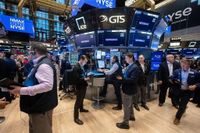On April 3, 2025, the stock market suffered its worst day since June 2020, primarily driven by newly imposed tariffs from the Trump administration that sent shockwaves through various sectors, particularly e-commerce giants like Amazon. Retail traders, however, were among the few investors who took advantage of the market's downturn, purchasing stocks in hopes of long-term gains.
The S&P 500 index closed almost 5% lower, with Amazon's stock plummeting nearly 9% to $178.41. This decline erased over 30% of the gains Amazon had made throughout 2024, bringing its share price back to levels not seen since early 2024. The e-commerce giant's stock was particularly vulnerable due to its significant reliance on international supply chains, which are now threatened by the new tariffs.
President Trump announced sweeping tariffs on April 2, 2025, that included a 10% base level on all imports and even higher rates on approximately 60 other countries, including a staggering 25% on foreign-made automobiles. This move was met with immediate backlash from investors, with the Dow Jones Industrial Average losing 3.7% and the NASDAQ skidding 5.7%. Bloomberg estimated that the U.S. stock market would lose around $2 trillion as a result of the tariffs.
Amazon's stock was particularly hard hit, dropping as much as 9.7% at one point during the trading day. Analysts noted that this was not the first time Amazon had faced such volatility. The company has a history of bouncing back from significant price drops, including a 22% crash at the onset of the COVID-19 pandemic and various earnings misses in previous years. For instance, in August 2024, disappointing earnings reports led to an 8.8% drop, while a 14.1% plunge occurred in April 2022 after another earnings miss.
Despite the current turmoil, some analysts view this downturn as a buying opportunity. Amazon's fundamentals remain strong, with a trailing P/E ratio of 32.76—close to its 10-year low—and a price-to-book ratio of 6.71, nearing a two-year low. The company's Altman Z-score of 5.48 indicates financial stability, and its Piotroski F-Score of 7 highlights a healthy financial situation. Moreover, Amazon's revenue growth rate is 8.6% for the past year and 15.4% annually over the last five years.
Retail investors, buoyed by the data from Fidelity Investments, were seen buying into stocks like Amazon and the Vanguard S&P 500 ETF, betting that the market's latest tumble would provide a contrarian opportunity for long-term gains. This sentiment reflects a growing trend among small investors who have increasingly engaged in the stock market over the past few years.
However, the market's reaction to the tariffs has raised concerns about the broader implications for e-commerce. Analysts have pointed out that over 50% of the sellers on Amazon's platform are based in China, making the company particularly susceptible to the fallout from these tariffs. Furthermore, the end of the de minimis exemption for small imports, which previously allowed packages valued at $800 or less to enter the U.S. duty-free, could further complicate matters for Amazon and similar platforms.
In a bid to counteract the negative effects of the tariffs, Amazon submitted a last-minute bid for the U.S. operations of China's TikTok, hoping to leverage the platform for advertising its e-commerce products. Yet, the bid was perceived as low and not taken seriously by the administration, which has set an April 5 deadline for TikTok to divest its U.S. operations.
As the market continues to react to the tariffs, analysts are divided on the future trajectory of Amazon's stock. Some believe that the current downturn is merely a short-term shock, while others caution that the company may face prolonged pressure from increased tariffs and declining consumer confidence. The Fibonacci retracement levels suggest potential support at $173.37 and $164.44, but traders will be watching closely for any signs of recovery.
Investors who bought Amazon shares five years ago would have seen their initial investment of $1,000 grow to approximately $1,914 today, indicating the company's long-term growth potential despite recent setbacks. With the current market volatility, many investors are left wondering whether now is the right time to buy more shares or to wait for a clearer signal of recovery.
In conclusion, while the immediate future for Amazon and the broader stock market appears uncertain due to the impact of President Trump's tariffs, the long-term outlook for the e-commerce giant remains promising, provided it can navigate these challenges effectively. Retail investors seem undeterred, viewing the current dip as an opportunity, but the overall market sentiment remains cautious as the implications of these tariffs continue to unfold.









